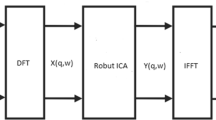Abstract
This paper proposes an algorithm for the second-order blind signal separation problem with convolutive mixtures. An iterative first order gradient method based on the accelerated gradient is developed for solving the optimization problem. For each search direction, the question becomes how to effectively calculate the optimal step size in each iteration. Here, we propose an efficient algorithm for obtaining the step size by first reformulating the objective function as a fourth order polynomial in terms of the step size, where the polynomial coefficients are required to be calculated only once per iteration. An optimal step size search procedure using the Newton’s method is developed with the step size is efficiently obtained for each iteration. Simulation results in a simulated room environment and a real environment show that the proposed algorithm converges faster than the existing methods with a lower number of iterations and a lower computational complexity. In addition, the proposed algorithm can separate the speech signals and reduce the background noise simultaneously.






Similar content being viewed by others
References
Antonia, J., and Chauhan, S. (2013). A study and extension of second-order blind source separation to operational modal analysis. Journal of Sound and Vibration, 332(4), 1079–1106.
Beck, A., and Teboulle, M. (2009). A fast iterative shrinkage-thresholding algorithm for linear inverse problem. SIAM Journal on Imaging Sciences, 2(1), 183–203.
Buchner, H., Aichner, R., and Kellermann, W. (2005). A generalization of blind source separation algorithms for convolutive mixtures based on second-order statistics. IEEE Transactions on Speech and Audio Processing, 13, 120–134.
Chabriel, G., Kleinsteuber, M., and Moreau, E. (2014). Joint matrices decompositions and blind source separation: A survey of methods, identification, and applications. IEEE Signal Processing Magazine, 31(3), 34–43.
Dam, H. H., Cantoni, A., and Li, B. (2015). A fast low complexity method for optimal zero-forcing beamformer MU-MIMO system. IEEE Signal Processing Letters, 22(9), 1443–1447.
Dam, H. H., Cantoni, A., Nordholm, S., and Teo, K. L. (2008). Second-order blind signal separation for convolutive mixtures using conjugate gradient. IEEE Signal Processing Letters, 15, 79–82.
Dam, H. H., Nordholm, S., Low, S. Y., and Cantoni, A. (2007). Blind signal separation using steepest descent method. IEEE Transactions on Signal Processing, 55(8), 4198–4207.
Dam, H. H., Rimantho, D., and Nordholm, S. (2013). Second-order blind signal separation with optimal step size. Speech Communications, 55(4), 535–543.
Giselsson, P., Doanb, M. D., Keviczky, T., Schutter, B. D., and Rantzer, A. (2013). Accelerated gradient methods and dual decomposition in distributed model predictive control. Automatica, 49, 829–833.
Lahat, D., Cardoso, J.-F., and Messer, H. (2012). Second-order multidimensional ICA: Performance analysis. IEEE Transactions on Signal Processing, 60(9).
Lehmann, E., & Johansson, A. (2008). Prediction of energy decay in room impulse responses simulated with an image-source model. Journal of the Acoustical Society of America, 124(1), 269–277.
Parra, L., and Spence, C. (2000). Convolutive blind separation for non-stationary sources. IEEE Transactions on Speech and Audio Processing, 6(3), 320–327.
Tseng, P. (2008). On accelerated proximal gradient methods for convex concave optimization. SIAM Journal on Optimization. http://www.math.washington.edu/tseng/papers/apgm (submitted for publication).
Author information
Authors and Affiliations
Corresponding author
Rights and permissions
About this article
Cite this article
Dam, H.H., Nordholm, S. Accelerated gradient with optimal step size for second-order blind signal separation. Multidim Syst Sign Process 29, 903–919 (2018). https://doi.org/10.1007/s11045-017-0478-8
Received:
Revised:
Accepted:
Published:
Issue Date:
DOI: https://doi.org/10.1007/s11045-017-0478-8




